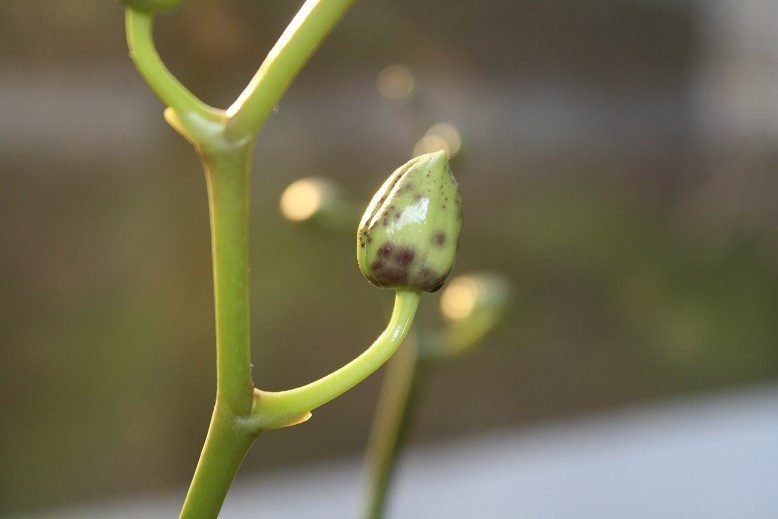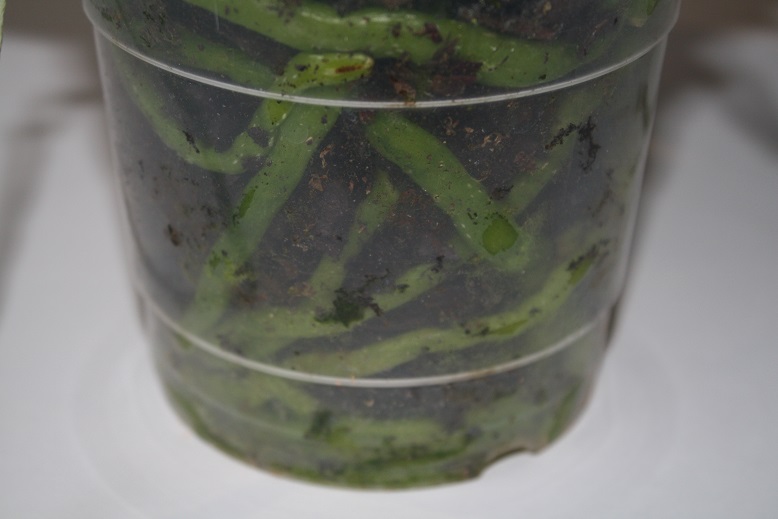In this article you will find information and tips about cutting orchids. When, how and why you may, can or should cut roots, leaves and flower shoots of orchids, you will now learn.
Contents
Cutting flower shoots of orchids with Phalaenopsis
A question that will be on the mind of anyone who has an orchid on their windowsill at some point is when is the right time to cut off a faded flowering shoot, and what is the best way to do it.
With Phalaenopsis orchids there is a very simple rule. If the flowering shoot is still green, but has already shed all its flowers and has not formed any new buds at its tip for a while, you can cut it off.
In this case, use a sharp knife or special plant shears (affiliate link*) to cut off the flowering shoot above one of the nodes. Nodes are called the thickenings that are found at regular intervals on the flower shoots.
It has proven useful to cut off the still green but faded flower shoot immediately above the third node counted from the bottom. After that it is time to wait.
With a little luck, cutting above the node will encourage the orchid to form a new side shoot from the node, on which it will then form buds and bloom.
If the flowering shoot does not form new buds and flowers and becomes brown and dry after some time, you can cut it off as far down as possible at the base. The orchid will then, with good care, conjure up a completely new flower shoot from its stem.
Sometimes two or even three at once. If the new flower sprout takes a long time to appear, perhaps my tips for renewed flowering will help. Also, flower shoots that become brown and dry as a whole, you can simply cut off at the base.

Cutting flower shoots of orchids in other genera.
In many other orchid genera, such as Dendrobium or Oncidium, a faded flower shoot can be cut off immediately at the very bottom.
If you like, you wait until the flower shoot is brown and dried up to make sure that the plant has recovered the ingredients, such as the green leaf pigment chlorophyll. But new flowers are no longer expected here.
However, there are also orchid species where a flowering shoot should not be cut off prematurely under any circumstances. Among them is Paphiopedilum Pinocchio. The revolver bloomer can continue to bloom on one flowering shoot.
So cutting it off prematurely would be fatal and would deprive you of tens of future flowers. Even if this lady’s slipper pauses for a while, the next bud will form quite reliably at some point.
Cutting the roots of orchids
In addition to the flower shoots, the roots of orchids also eventually become a case for scissors or knife. Namely, when they are either muddy and rotten or hollow and dried up. In both variants, they are no longer useful to the orchid for water absorption and can be safely removed in favor of new root growth.
However, hollow orchids that still have an intact looking filament in them can, as far as I know, be left standing or simply have the hollow around removed and not have the filament cut off.
This is a conduit through which the orchid, even if it doesn’t appear to be, can still absorb water. Also check out my tips on how to properly water orchids.
Contrary to other statements, you should never cut intact roots in my opinion. No matter if you have too many aerial roots growing on the orchid and you don’t like the look or if you don’t have a bigger pot at hand when repotting and therefore want to get rid of roots in the pot.
My motto is: Hands off healthy roots. You should also be careful when repotting orchids and damage the roots as little as possible. This is how you repot your orchid step by step.

Cut the leaves of orchids?
Leaves should be cut only in the greatest emergencies, and in no case because they have visual blemishes or the like. A leaf with sunburn, for example, can still photosynthesize with the remaining green leaf area and supply the plant.
Of course, it’s best to prevent sunburn anyway (affiliate link*) . Cutting off a leaf wantonly, for whatever reason, can weaken the plant.
In addition, the cut is a prime entrance door for infections or pests of any kind. So this should be avoided at all costs.

It is usually the case with orchids that the leaves themselves decide when they are too old, and then simply turn brown and eventually fall off at a predetermined breaking point. At best, you should just let them do that or only very lightly help when the leaf is already really dried up.
As long as it does not fall off at the lightest touch, it is not yet ripe. Again, just be patient and let the plant do its thing.
Practical information about cutting orchids
Now you know when and why you should and can cut off flower shoots, roots and leaves – or not. The question remains, what is the best way to cut. There are really only three points to consider:
Take a sharp knife, scalpel or sharp, small plant shears (affiliate link) that are clean, at best sterile or boiled. Cut carefully so that you don’t injure other, intact plant parts if possible. After cutting, dab the cut with activated charcoal powder or high-quality cinnamon powder (affiliate links). Both contain active ingredients that can prevent or inhibit infection with germs.
If you heed my advice, there should be no problems with proper orchid trimming from now on. And your plants will hopefully thank you with lush blooms.
If you are looking for information on how to cut off orchid cuttings, you can find this information in my article on orchid cuttings.
Continue to enjoy your orchids and good luck with your diligent orchid pruning!


